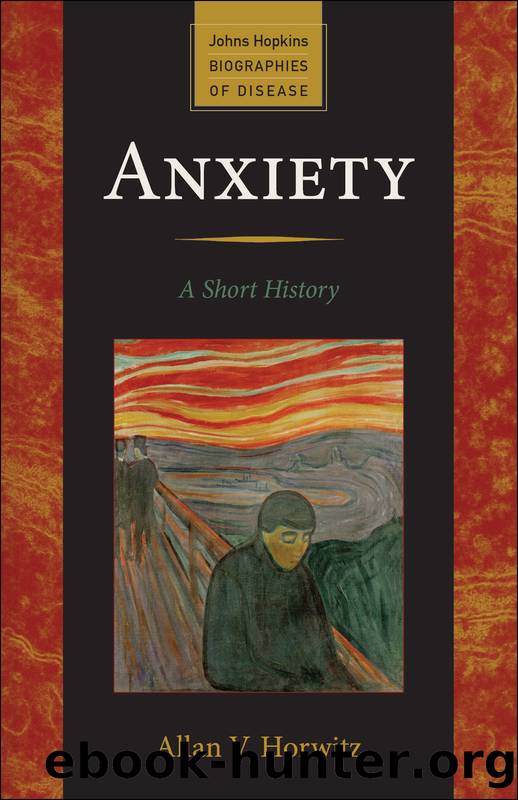Anxiety by Allan V. Horwitz

Author:Allan V. Horwitz
Language: eng
Format: epub
Publisher: Johns Hopkins University Press
Published: 2013-08-14T16:00:00+00:00
THE DECLINE OF PSYCHOANALYSIS
In the late 1960s the analytic view of anxiety began a steep decline that accelerated during the next decade. Psychiatry had been the institutional home of psychoanalysis, but the profession now turned sharply against the analytic view of anxiety and other disorders. One reason was the growing power of psychiatric researchers, who scorned the analysts’ casual attitude toward measurement. Another was the rise to prominence of biological psychiatrists, who disparaged the analysts’ focus on the unconscious, their lack of empirical rigor, and their neglect of the brain. The dominance of the analytic approach in academic departments of psychiatry faded and the number of psychiatrists identifying with psychoanalysis drastically shrunk. Once their institutional base in psychiatry crumbled, analysts fled to independent institutes, which opened themselves to all comers, not just physicians. Once psychiatry severed its ties with psychoanalysis, the prestige of psychoanalysis plummeted.
Psychoanalysis lost its social, as well as institutional, base. During the 1960s, the intellectuals and bohemians who had been among the most enthusiastic promoters of analysis in the 1920s and 1930s turned sharply against it. Far from identifying psychoanalysis with sexual liberation, rebels in the 1960s saw it as promoting conformity to repressive sexual and social roles. To them, analysis had abandoned the radical qualities that had provided much of its former allure. In addition, psychoanalysis had traditionally been identified with Jewish clients and practitioners but lost much of its appeal to Jews as they became increasingly assimilated within American society.44
The growing popularity of drug treatments also facilitated the fall of psychoanalysis. Although analysts often employed drugs in their practices, the use of medication was difficult to reconcile with their core theoretical tenets. One principle of psychoanalysis was that anxiety was therapeutically essential, because it motivated patients to explore their repressed thoughts and experiences. The tranquilizing drugs (discussed in Chapter 7) that became widely used in the 1950s and 1960s reduced the amount of experienced anxiety. This chemical suppression of anxiety could discourage the search for the underlying causes of neuroses. As the psychiatric profession came to organize itself around drug treatments, the influence of Freudian views of anxiety became marginalized. The analytic treatment of anxiety also became a luxury: why should people undergo long, expensive, and painstaking periods of analysis when a pill could provide them with immediate relief from their pain? Psychoanalysis couldn’t match the ease, efficiency, and symptom relief of medication-based therapies.
The expense and inefficiency of psychoanalysis also led public and private funders of treatment to cast a wary eye on it. Third party payers became skeptical of the value of analytic therapies and became less willing to pay for them. As the proportion of patients using insurance and public funding to pay for treatment grew exponentially during the 1960s, economic support for psychoanalysis weakened and this therapy became limited to the small number of people who had the resources, time, and desire to pursue it.
Moreover, the movement of psychoanalysis, especially its neo-Freudian branch, toward a focus on social and environmental problems became politically toxic.
Download
This site does not store any files on its server. We only index and link to content provided by other sites. Please contact the content providers to delete copyright contents if any and email us, we'll remove relevant links or contents immediately.
| Administration & Medicine Economics | Allied Health Professions |
| Basic Sciences | Dentistry |
| History | Medical Informatics |
| Medicine | Nursing |
| Pharmacology | Psychology |
| Research | Veterinary Medicine |
Periodization Training for Sports by Tudor Bompa(8094)
Why We Sleep: Unlocking the Power of Sleep and Dreams by Matthew Walker(6549)
Paper Towns by Green John(5022)
The Immortal Life of Henrietta Lacks by Rebecca Skloot(4444)
The Sports Rules Book by Human Kinetics(4209)
Dynamic Alignment Through Imagery by Eric Franklin(4044)
ACSM's Complete Guide to Fitness & Health by ACSM(3934)
Kaplan MCAT Organic Chemistry Review: Created for MCAT 2015 (Kaplan Test Prep) by Kaplan(3904)
Introduction to Kinesiology by Shirl J. Hoffman(3697)
Livewired by David Eagleman(3618)
The River of Consciousness by Oliver Sacks(3493)
The Death of the Heart by Elizabeth Bowen(3480)
Alchemy and Alchemists by C. J. S. Thompson(3419)
Bad Pharma by Ben Goldacre(3205)
Descartes' Error by Antonio Damasio(3185)
The Emperor of All Maladies: A Biography of Cancer by Siddhartha Mukherjee(3018)
The Gene: An Intimate History by Siddhartha Mukherjee(3012)
The Fate of Rome: Climate, Disease, and the End of an Empire (The Princeton History of the Ancient World) by Kyle Harper(2973)
Kaplan MCAT Behavioral Sciences Review: Created for MCAT 2015 (Kaplan Test Prep) by Kaplan(2899)
